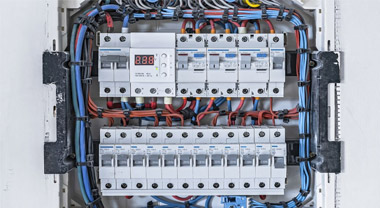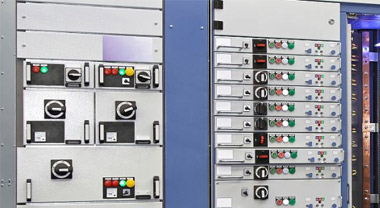Selection principle and setting principle of low voltage circuit breaker
When designing and selecting low-voltage circuit breakers, the general principles that need to be considered are:
- Determine the type of circuit breaker to be selected according to the load nature, fault category and line protection requirements of the low-voltage power distribution system, and comply with the current relevant national standards.
- The rated voltage and frequency of the circuit breaker should be compatible with the nominal voltage and nominal frequency of the circuit.
- The rated current of the circuit breaker should not be less than the calculated load current of the circuit.
- The circuit breaker should adapt to the environmental conditions of the place. ⑤The circuit breaker should meet the requirements of dynamic stability and thermal stability under short-circuit conditions. When used to disconnect short-circuit current, it should meet the making and breaking capacity under short-circuit conditions.
Low-voltage circuit breakers should choose the appropriate protection form according to different fault categories and specific engineering requirements. The setting principles generally include:
- In normal use of the circuit breaker and when the electrical equipment is started normally, the installed protection should not operate.
- The most fundamental task of the circuit breaker is to play a protective role. It must be able to effectively cut off the faulty circuit within the specified time and meet the most basic requirements of the specification.
- The protective action characteristics of the circuit breakers at all levels of the low-voltage power distribution system should be able to coordinate with each other. There should be selective action, that is, when a fault occurs, the circuit breaker protection close to the fault point should be cut off first, and the upper part close to the power supply side should be cut off first. The primary protection should not be activated, and the power outage range should be reduced as much as possible.
In the low-voltage power distribution system, the main design task is to select the protective electrical appliances reasonably, according to the requirements of the circuit breaker's setting principles, through correct setting of its parameters to achieve various protection functions, but these setting principles may contradict each other. For example: the rated current or the setting current of the circuit breaker is limited by items ① and ② of the setting principle, and the speed of the protection action is restricted by the items ② and ③ of the setting principle, so it must be calculated accurately and carefully Verify, coordinate the contradictions between each other, realize the unity of opposites, in order to comply with the relevant requirements of the operating characteristics, operating time and selective protection specified in the specification.
When designing and selecting low-voltage circuit breakers, it is first necessary to comply with the electrical design specifications in national standards such as GB 50054-1995 "Low-Voltage Power Distribution Design Code" and manuals such as "Industrial and Civil Power Distribution Design Manual". As a manufacturer of low-voltage circuit breakers, Haige Electric hopes to discuss this topic from a different perspective.
The manufacture of low-voltage circuit breakers is based on the national standards GB14048-2 (equivalent to IEC 60947-2) "Low-voltage switchgear and control equipment low-voltage circuit breakers" and GB10963 (equivalent to IEC 60898) "Overcurrent protection circuit breakers for household and similar places" According to the basis, when designers choose our products, they actually recognize the above-mentioned two national product standards. From this perspective, it is very necessary for designers to understand these two standards and briefly introduce a few issues that are easy to overlook:
- Low-voltage circuit breakers manufactured with the above two product standards are generally called general-purpose circuit breakers. I apply the scope of clause 1.1 in the product standard: "For circuit breakers for certain specific purposes (such as traction, rolling mills and marine), some necessary special regulations and supplementary requirements can be made" and Appendix E "Submit to the manufacturer for consultation with the user The understanding of these two clauses is that when some special purpose circuit breakers exceed the product standard, the user and the manufacturer need to negotiate and confirm the performance and electrical parameters of the circuit breaker to meet user needs.
- The most important function of the circuit breaker is to provide timely trip protection in the event of a line failure. The designer is very concerned about whether the circuit breaker can ensure that the faulted line is properly cut off when the selected trip current value occurs. It is necessary to understand the ambient temperature of the trip value setting of the circuit breaker manufactured in accordance with the standard of Clause 6.1.1 of GB 14048-1: “The ambient air temperature does not exceed +40 ℃, and the average temperature within 24 hours does not exceed +35 ℃", when the ambient temperature of the circuit breaker determined by the designer is higher than the above temperature, the temperature coefficient needs to be adjusted. The circuit breaker manufacturer will provide the "temperature correction factor" in the product catalog as a reference for designers when designing.
- According to clause 6.1.2 of GB14048-1, the altitude requirement of the installation site is: "The altitude of the installation site does not exceed 2 000 m". If the installation site exceeds the altitude requirement of 2 000 m, the manufacturer can make special manufacturing according to the agreement with the user or the designer can reduce the capacity according to the manual guidance method such as "Industrial and Civil Power Distribution Design Manual".
- In accordance with the requirements of national product standards, the manufacturer also provides a correction factor for each circuit breaker selection when multiple circuit breakers are installed in parallel in the product catalog for reference.
- The manufacturer did not provide the circuit breaker derating correction factor when multiple cables are laid side by side, but the designer should consider the requirement of overheating protection when the circuit breaker protects multiple cables when laid side by side, which has exceeded the standard for manufacturers. In this regard, refer to the "Industrial and Civil Power Distribution Design Manual" or similar manuals for the use of correction factors for circuit breaker derating.
- The error of the agreed trip current value also needs to be reminded of the designer, see GB 14048-2 clause 7.2.1.2.3 "Accuracy of trip current value ± 20% (brief description)". This is why many design manuals and discussions have talked about two series-connected upper and lower circuit breakers passing the same load current, when the rated current In is selected: if they are all similar circuit breakers, the upper circuit breaker In must be at least 1.6 In larger than the lower circuit breaker. The relationship between multiple times can be selectively tripped. Engineers can understand that high-precision means high cost in the industry. If high-precision circuit breakers are required, users and manufacturers need to negotiate, and the price of the product may also increase significantly.
General principles for the selection of general low-voltage circuit breakers:
- The rated voltage of the low-voltage circuit breaker ≥ the rated voltage of the line.
- The rated current of the low-voltage circuit breaker ≥ the calculated load current of the line.
- The limit on-off capacity of the low-voltage circuit breaker is greater than or equal to the maximum short-circuit current in the line.
- Single phase-to-ground short-circuit current at the end of the line ≥1.25 times the instantaneous (or short delay) tripping setting current of the low-voltage circuit breaker.
- The rated current of the release ≥ the calculated current of the circuit.
- The rated voltage of the undervoltage release = the rated voltage of the line.
- The rated voltage of the shunt release of the circuit breaker = the voltage of the control power supply.
- Rated working voltage transmitted to the mechanism by electric motor=control power supply voltage.
Setting principles of low-voltage circuit breakers:
- During normal operation and normal starting, the circuit should not be cut off. Regarding that the circuit breaker does not operate when starting, take a representative cage motor as an example, and perform calculation and verification according to the following requirements. The setting current Ir1 of the long time delay release of the circuit breaker generally does not consider the influence of the motor starting. The setting current Ir2 of the short-delay release should avoid the starting current of the largest motor. Use the following formula to calculate Ir2≥1.1 (IL+1.35 KIMm). In the formula, IL is the calculated load current of the line, A; K is the maximum one. The starting current multiple of the motor; IMm is the rated current of the largest motor, A. The instantaneous release setting current Ir3 should avoid the full starting current of the largest motor. Use the following formula to calculate Ir3≥1.1 (IL+K1 KIMm), where IL is the calculated load current of the line, A; K1 is the peak factor of the motor starting current , K1=1.7~2; K is the starting current multiple of the largest motor; IMm is the rated current of the largest motor, A.
- When the circuit is faulty, the faulty circuit should be cut off reliably.
- When the circuit is faulty, all levels of protection appliances should selectively cut off the circuit.
These three requirements are often contradictory. The task of power distribution system design is to select the protection appliances reasonably and set their parameters correctly. For example, the rated current or the setting current of the protection appliances is limited by items 1) and 2). The speed of the action time is restricted by items 2) and 3). It is necessary to carefully calculate, verify, coordinate contradictions, and realize the unity of opposites to meet the requirements of the specification.




